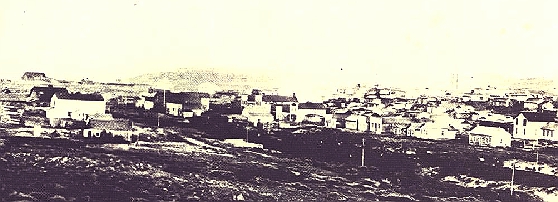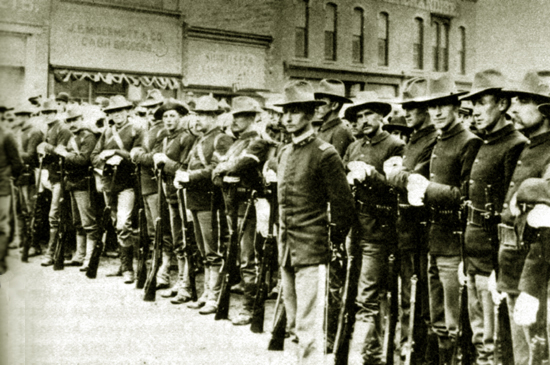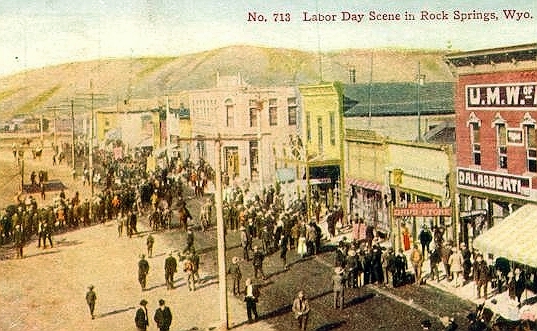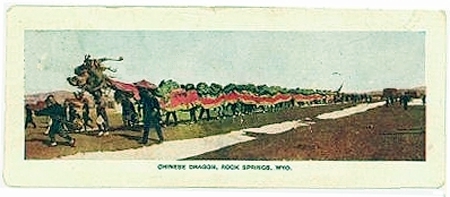
As may be seen from the above map, 40% of Wyoming is underlain by coal. The state
is the largest producer of coal in the United States producing 30% of all coal
mined in the country. In general, coal deposits in Wyoming relate to two distinct periods in Wyoming's geologic
history. The deposits in Southwest Wyoming near Evanston date to the Cretaceous Period some 140 millions years ago. Deposits
in the Northeast portion of the state date back to the Paleocene Epoch between 65 to 54 million years
ago. In contrast, coal deposits in Pennsylvania are some 300 million years of age. As noted with regard to the
discussion of Oil Camps, during the Cretaceous Period there was a
Western Interior Seaway connecting the Arctic Ocean with the Gulf of Mexico. In the southwestern
portion of what is now Wyoming there were coastal swamps in which peat beds formed and which with
time compressed to form coal beds. The end of the Cretaceous Period and the beginning of the
Paleocene Epoch was marked by the mass extinction of
dinosaurs and the so-called K/T boundary. The boundary is denoted by a deposit of material from the
collision of a giant asteroid with the Earth on the northern coast of the Yucatan.
At the end of the Cretaceous Period and extending maybe three million years into
the Paleocene Epoch, a remnant of the Western Interior Seaway, known as the "Cannonball Sea," existed in what are
now the Dakotas. Into this sea, rivers and streams flowed northeasterly from what is now
northwestern Wyoming. And as the sea retreated, the rivers became fluvial swamps. Mountains arose and
cut off interior basins in which were formed lakes. Perhaps, one may see the signs of these rivers and
lakes in the map above. The climate was subtropical, and palms and crocodilians flourished.
The lakes became swamps; and vegetation filled the swamps and settled into the murky depths or
floated on the surface as peat islands, much as in the present-day Okefenokee Swamp of coastal Georgia.
As water levels rose and fell, greater and greater layers of peat formed ultimately compressed into
coal beds as much as 60 meters thick. An idea of the thickness of the peat beds may be obtained in
that one foot of coal may represent 20 feet of peat.
Millions of years passed. The Rockies arose. The Tetons formed. The North American
Plate drifted westerwardly over a "hot spot" beneath the earth's crust. The hot spot would periodically erupt
forming giant calderas as much as twenty miles in width. The remnants of one forms
present day Lake Yellowstone. Periodically, the climate would change and glaciers would push over
the land, carving the mountains and forming moraines which today may be seen in Jackson Hole. With the Ice Ages,
the ocean levels fell and man crossed over the land bridge from Siberia to Alaska and
man appeared in Wyoming about 11,500 years ago. The coal remained for its
discovery by the Fremont Expedition of 1843.

Carbon, Wyoming, undated
Commercial mining came with the arrival of the Railroad. At first,
the coal mines were held by the Wyoming Coal and Mining Company with the first mines at Carbon,
west of Medicine Bow, and at Rock Springs. The first dwellings at Carbon consisted of little more that
dugouts and "shoddies" consisting of upright boards, chinked with sod, with sod roofs. Carbon, now a ghost town,
grew to a population of about 3,000 residents, with a state bank, newspaper and seven active mines.
Mines were ventilated by the use of traps at the mine entrances. Traps would be opened in
the direction from which wind was blowing, permitting fresh air to blow into the mine.
The Town's fate was sealed, first by a fire on June 19, 1890, which was stopped
only by dynamiting buildings and secondly, by the relocation of the railroad
through Hanna in 1899. The relocation was prompted by the finding of a route
which avoided the six-mile grade at Simpson Hill and the necessity of
double-heading the locomotives. By 1902 Carbon was abandoned and nothing
remains except the cemetary and a few sandstone foundations.
Ninety percent of the stock in Wyoming Coal was held by some of the
directors of the Union Pacific, including Oliver Ames and provided an additional method of
milking the railroad. The Company leased the land from the Railroad, and then the
coal was sold to the railroad at a guaranteed profit. As a result of governmental investigation, the contract between
Wyoming Coal and the Railroad was terminated in 1874 and the Union Pacific took over the mines.

Rock Springs Coal Tipple, undated
Originally the term "tipple" referred to the place where the mine cars would be tipped to
unload the coal. Later the term was used to refer to the entire facility where coal would be
sorted, screened, and picked prior to shipment. In the larger tipples, the coal would be
tipped into a hopper. From there the coal would go onto a conveyor belt known as an "apron feeder" where the coal
would go through a series of shakers and screens which would sort the coal by size. Coal would
pass over "picking tables" where employees known as "pickers" would remove rocks and other
unsuitable material, before the coal would be emptied into railway cars.
With control over the only means of transportation, the Union Pacific was able to
maintain a monoply on coal production. As an example, in 1874, in Omaha the Railroad charged customers
for its coal $9.00 a tom. It charged independent producers $10.00 a ton to transport
their coal to Omaha. The Company displayed similar beneficence in its labor policies. In
1875, the Company cut the piece-work rate paid to miners by one-fifth but made no corresponding
reduction in prices charged at the Company stores. When the miners went on strike, the Company's
response was to replace them with Chinese.

The Rock Springs Massacre, 1885, Harper's
Weekly
Resentment, continued until it boiled over on September 2, 1885,
when word was received that Colorado miners were receiving a pay raise
but the ones in Rock Springs were not. The Welsh and the Swedish miners,
most of whom were members of the militant Knights of Labor under the
leadership of the union's Grand Master Workman Terrence V. Powderly (1849-1924), rose up, burned the homes of
approximately 75 Chinese families, 28 Chinese were killed and 15 wounded.
The Chinese fled toward Green River and were rescued by the Union Pacific.

Federal Troops on South Front Street, Rock Springs, 1885. National Archives Photo.
Federal troops were brought in to restore order and remained in Rock Springs
until 1898.

The Chinese Examining Commission at Rock Springs, 1885, Harper's
Weekly. L to R, Lt. Groesbeck; Tsang Hoy, interpreter from Chinese Legation;
Frederick A. Bee, lobbyist and lawyer for the Chinese Consolidated Benevolent Association (the "Six Companies"),
San Francisco; Huang Sih Chuen, Chinese Consul, New York;
unidentified; Lt. Col. (Brevet Maj. Gen.) Alexander McDowell McCook, Commander
Fort Leavenworth.
[Writer's note: Frederick A. Bee was also one
of the organizers of the Pony Express and developer of the Sausalito Land and
Ferry Company. The CC Benevolent Association, founded in 1862, is still in existence with branches nationally.]
 Knights of Labor Ensignia Knights of Labor Ensignia
The Knights of Labor, officially The Noble and Holy Order of the Knights of Labor,
was originally organized in Philadelphia in 1869. Its original founders were members of various
fraternal orders including the Masons, Knights of Pythias, Odd Fellows, and the Improved Order
of Redmen. Thus, although it was a labor union, it was organized in the same
manner as fraternal orders with a secret ritual, an initiatory "Pledge of Honour," secret signs, handshake, and passwords, and fraternal regalia. Powderly,
although an Irish Catholic, was also a Mason.
With some change of terminology, the ritual of the Order would sound very similar to members of other fraternal orders.
The lodge room or assembly hall was known as the "Sanctuary" and the entrance door was known as the "Veil."
The officers included the Master Workman, the Worthy Foreman, the Worthy Inspector, the Venerable Sage, the Unknown Knight, the
Inside Esquire, and Outside Esquire.

Editorial Cartoon by Thomas Nast, Harper's Weekly
By the time of the Rock Springs massacre,
the Order had obtained a national membership of approximately 700,000.
The Chinese laborers presented a memorial to the Chinese Consulate in New York detailing the
attack upon the Chinese miners. An
investigation was conducted resulting in reparations.
Although the Knights of Labor supported the Chinese Exclusion
Act, it was officially open to all including women and Blacks. At the
1886 Grand Assembly, Grand Master Workman Powderly was introduced by a
Black delegate from New York. The only ones not
eligible for membership were gamblers, saloon-keepers, lawyers, and
bankers. Following an unsucessful railroad strike in Texas and the Massacre,
the Order began a precipitous decline in membership and was rapidly replaced by
other unions. Strikes and discrimination against Chinese, however, were a violation of the principles of the Order as explained in
its initiatory ritual. In the charge given by the Master Workman, the new member was instructed:
We shall use every lawful and honourable means to procure and retain
employ for one another, coupled with just and fair remuneration; and should
accident or misfortune befall any of our number, render such aid as
lies within our power to give, without inquiring their country or creed, and without
approving of general strikes among artisans; yet should it become justly necessary
to enjoin an oppressor, we will protect and aid any of our members who
thereby may suffer loss, and as opportunity offers, extend a helping hand to
all branches of honourable toil."
In 1893, Powderly was voted out of office. The following year
he became a lawyer. In 1916, the Order's last Grand Master Workman,
John W. Hayes, closed the central office and placed its records in a shed behind an
insurance office in Washington, D.C. In Rock Springs, the United Mine Workers replaced the
Knights of Labor and by 1908, Chinese
were attending UMWA meetings in Rock Springs. Today, each September we celebrate a holiday
started by the Knights of Labor, Labor Day.

Labor Day Celebration, Rock Springs
Rock Springs, however, was not the only place in the west in which
Chinese were forcibly ejected from their homes and work. In September 1885, three Chinese hop pickers were murdered in Washington State. A
short time later Chinese employed by the Oregon Improvement Company were burned out of
their quarters. In Takoma, the sheriff and the mayor loked on while a groupt affiliated
with the International Workingmen's Association routed Chinese. In January
1886, in Maiden, Montana, masked, armed miners "escorted" Chinese out of
town, allowing them to send the next day for their belongings. The [Maiden]
Mineral Argus congratulated its readers on the peaceful manner in which
the Chinese were excluded.
 Chinese Dragon, Rock Springs, approx. 1908
Chinese Dragon, Rock Springs, approx. 1908
The dragon cost approximately $3,000.00. It was displayed at the 1892 Columbian Exposition in
Chicago.
Other strikes also occured. In 1894, The Pullman Company laid off one-third of its workers and
slashed the wages of the remaining employees. As a result railroad workers struck
in sympathy. President Cleveland used the Army to break the strike and the
federal court directed that more than 800 Railroad employees in Wyoming be discharged.
The result was a boycott against the military and the United States Marshals. This in
turn resulted in the arrest of, among others, the city marshal.
Next Page: Coal Camps continued, Hanna, Diamondville.
|